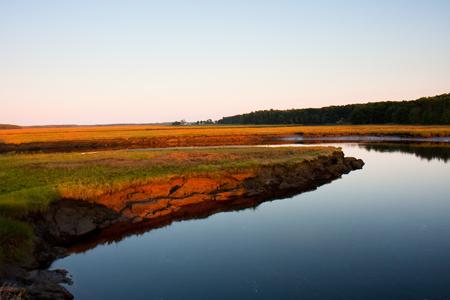EPA Science Matters Newsletter: Climate Change and Watersheds: Exploring the Links (Published August 2013)
EPA researchers are using climate models and watershed simulations to better understand how climate change will affect streams and rivers.

A warming climate threatens hotter summers and more extreme storms. We know we may need to upgrade our air conditioning systems and make emergency preparedness kits, but aside from temperatures and storms, what are other ways we will be affected by climate change.
EPA water scientists and their partners are studying how climate change may affect watersheds—the network of rivers and streams that feed into larger water bodies such as big rivers, lakes, and oceans. A recent EPA report, referred to as the 20 Watersheds Report, combines climate change models and watershed simulations to develop a better understanding of what changes to streams and rivers we might expect over the next several decades.
“A key thing that’s unique about this work is the scope; we applied a consistent set of methods and models to 20 large watersheds throughout the nation,” says lead scientist Tom Johnson.
Johnson’s team of researchers used different climate change scenarios to model changes in streamflow volume and water quality in the 20 chosen watersheds.
“Climate can be defined loosely as average weather,” Johnson explains. “Climate change scenarios describe potential future changes in climate, like temperature or precipitation.”
For a given climate change scenario, watershed simulations were used to determine changes in streamflow (the actual volume of water running through the streams) and in nutrient and sediment pollution levels.
In addition to climate change scenarios, researchers also took into account urban and residential land development scenarios in their watershed simulations. The ways people use and alter the land (such as building roadways, parking lots, etc) will also have an impact on water resources. The land development scenarios used were based on projected changes in population and housing density in the study watersheds.
Research results show a great variety in watershed responses to climate and urban development scenarios in different parts of the country. Generally, simulations suggest certain trends for streamflow: that flow amount decreases in the Rockies and interior southwest, but increases in the northeast. Results also show higher peaks in streamflow that can increase stream bank erosion and sediment transport, as well as potentially increase nutrient pollutants. Overall, the research shows that the potential changes in streamflow and water quality response in many areas could be very large.
“This information can be used by water managers to better understand if and how things like water quality and aquatic ecosystems might be vulnerable, and to help guide the development of response strategies for managing any potential risk,” says Johnson.
For example, where water is suggested to be scarce, managers can plan alternative water supply methods; where water is expected to become highly polluted from nutrients and sediment, managers can take action now to limit the actual impact of these pollutants on the water resource.
The findings of EPA’s 20 Watersheds Report will help water and resource managers recognize the changing conditions of streams and rivers and identify any future conditions that may need addressing.
- Using Three Watersheds to Compare Methods

Prior to undertaking the 20 Watersheds research project, EPA scientists completed a more modest study of three watersheds comparing different techniques to assess watersheds under changing climate conditions.
Researchers applied climate change scenarios to three very different types of watersheds: streams in southern Maryland, Arizona’s San Pedro River, and California’s Sacramento River. They then examined three different factors that could reflect watershed health under changing climate scenarios: fish populations, stream-side vegetation and wildlife, and water availability, respectively for each watershed.
By comparing watershed assessment techniques and results, researchers were able to identify assessment methods that worked well and areas where methods could be improved.
For example, researchers previously found it difficult to actually link the different models they were using (such as climate models to watershed models to fish models) to project changes in fish populations under climate change. As a result of this research, they will now be able to do so, incorporating the effects of climate change into new or existing models that advance the understanding of the impacts on watersheds and aquatic ecosystems.
This and other findings from this study helped pave the way for the larger-scale 20 Watersheds project.
- Developing Climate-Ready Methods for Assessing Rivers and Streams
EPA released Implication of Climate Change for Bioassessment Programs and Approaches to Account for Effects, a report using data from four states across the country to examine climate change effects on streams. The report presents research findings that will help states and tribes consider the impact of climate change on the aquatic organisms they examine to assess the health of aquatic resources to implement the Clean Water Act.
Data are presented on aquatic insects, water temperature, and flow to provide an informative and useful source of the impacts that climate change can have on streams, and advances strategies to ensure the effectiveness of monitoring and management plans under changing climactic conditions.
“The information presented in the report is valuable for state and other programs that are charged with protecting water resources to begin to incorporate climate change impacts into their decisions,” said Britta Bierwagen, Ph.D, an EPA researcher developing approaches to understand the impacts of climate change.
